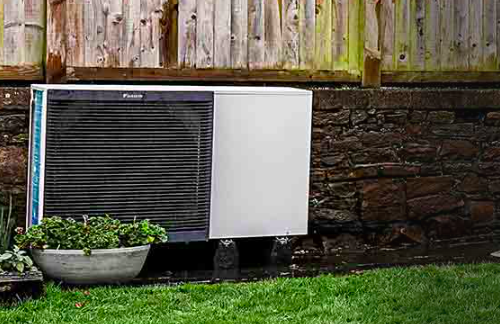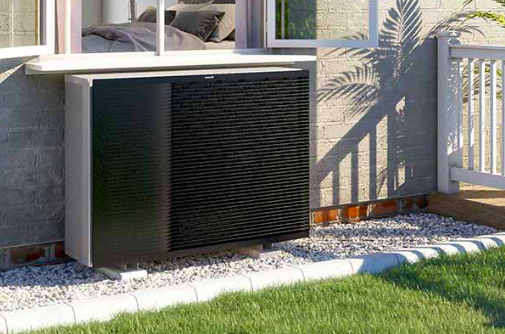Your guide to getting an Air Source Heat Pump
Of all the things we can do to lower our carbon footprint, changing our home’s heating system is right up there with installing solar panels, going vegan or changing the way we travel, as one of those big impact measures.
But it’s also about future proofing our home with a more sustainable heating technology and guaranteeing energy security too, so we’re not at the mercy of the fossil fuel markets.
Sounds appealing, doesn’t it?
New research by Samsung reveals 70% of heating industry professionals believe heat pumps could become commonplace in British homes as early as 2025 to 2030. And thanks to the government’s Boiler Upgrade Scheme (BUS), which has been running since May 2022, they’ve been getting a fair bit more attention too.
TWO FACTS TO KNOW:
The scheme, set up to boost installation of heat pumps and biomass boilers in both homes and non-domestic buildings, offers a grant of up to £5k (or £6k for a ground source heat pump) to homeowners that qualify.
There’s £450 million worth of government funding (yeah, wow!) YET a large portion of that hasn’t been spent; there’s been very little uptake here in England and Wales. And the scheme is set to finish in 2025. Possible causes for the lack of uptake include poor public awareness due to ineffective promotion of it by the government; and inadequate financial support for the associated costs of installing one.
Money is of course the big blocker. And in our current cost of living crisis, improving home insulation features fairly low in people’s priorities — despite the obvious longterm benefits and savings.
But many homeowners also doubt the feasibility of having an air source heat pump work for their property in the first place. And if it is feasible, how to go about getting one in without breaking the bank (even with the grant), and not knowing which company to trust to do the job!
So with a view to providing a little more clarity, here’s everything you need to know about Air Source Heat Pumps (ASHPs) — from first considerations, to costs, to installation, to managing your expectations…
FIRST… What is an Air Source Heat Pump (ASHP) and how is it better for the planet?
Air source heat pumps basically look like an air conditioning unit (that can attach to an external wall of your property) and work by extracting heat from the outside air, and raising the temperature of it through the use of a compressor — which works a bit like a reverse fridge. It’s then pumped indoors, through your central heating and hot water system. Heat is transferred via existing radiators or underfloor heating (and if used for water, via a hot water cylinder).
Air source heat pumps are powered by electricity, so with electricity grids increasingly drawing on renewable energy sources, they allow you to heat your home in a low carbon way.
Why might an Air Source Heat Pump be preferred over Ground Source?
Ground source heat pumps are similar but (as the name suggests) draw heat from underground as opposed to the air. The advantage of air source over ground source is that the air source heat pumps are cheaper to install and generally take up less space. Obviously great if you’ve got limited outside area! Ground pumps require trenches or boreholes to be dug, whereas air source heat pumps can attach to the side of the outside wall.
What’s the first step to installing an air source heat pump?
First, you want to get a better understanding of your property’s feasibility for an air source heat pump. And really this boils down (ahem) to how well insulated it is — and how efficiently your home can be heated.
A qualified heat pump installer can come and do an assessment, but before that, consider your home’s EPC rating — Energy Performance Certification (though according to a Sunday Times investigation, what’s in your property report might not be 100% accurate, so take it with a pinch of salt!), the age of your home, and the type of roof and external wall construction you have. Basically, it’s about learning how well-insulated your property is.
Most homes can be fitted with an air source heat pump. it’s just a case of how much work would need to be done to optimise its heating efficiency to make it worthwhile. Of course, work to improve insulation can be carried out in phases, over time. It doesn’t all have to be done at once.
If you’re not sure about any of this, you can bring in an engineer to carry out a room-by-room survey of the insulation features of your home. They’d estimate how much heat your property loses and also how much is needed to keep your home warm.
Your current heating system will be looked at. If you have radiators, they’ll be assessed on the basis of their surface area, and what would be needed to get the flow temperature right. A heating engineer would also look at your windows and seals, in addition to loft and wall insulation. At this point, they’ll know what modifications might be needed — if any — to install a highly efficient heat pump. Your home’s current pipework might allow for it, but if not, pipes can possibly be extended. Your heat pump would then be designed accordingly.
Who would do the installation?
Enlisting a qualified Microgeneration Certification Scheme (MCS) installer is part of the criteria if you want to take advantage of the grant. They’re also required to be registered with a consumer protection scheme such as RECC or HIES, to ensure you’re protected should anything go wrong.
It’s worth beginning your search with the gov.uk website database. Checkatrade is a great secondary resource for finding tradespeople within this area of specialism too and reading testimonials.
Will I have space?
People often assume lack of space will be an issue, but even small, older terraced properties can allow for a heat pump — it might just be a case of getting creative. Where the hot water cylinder goes is often the challenge, but this can fit into places you might not even have considered, like up in the eaves, on the joists. The issue might be more around whether the heat can be transferred appropriately to heat the home, as ASHPs generally require underfloor heating or larger sized radiators. Of course, you can install underfloor heating if you don’t currently have that, but this can cost as much as £3,000.
How much will it cost me then, all up, and will it save me money over the long-term?
Currently it costs on average about £10,500 (in the UK) to have an air source heat pump installed. With the government grant, this comes down to around £5,000. Compared to a gas boiler (which costs around £2,700), it’s obviously more expensive, but overall, the running costs are lower for heat pumps, assuming you have a well-installed system with good energy performance.
Running costs depend on your property size and how much heating you need, but taking into account that heat pumps tend to last longer (around 20-25 years versus 10-15 for a gas boiler) the lifetime cost comparison between the two forms of heating now lean in favour of the heat pump. Obviously that doesn’t take into account any investment needed for insulation upgrades, like enhanced loft insulation.
Towards the end of last year Octopus Energy struck a deal to manufacture them in Northern Ireland and say they can produce 1,000 a month, slashing the price for consumers to £2,500 (for installation as well) — which is around the same price as a gas boiler.
Financial benefits might not always be felt, though. Of course, having a heat pump can save you money over time, but the savings might be minimal and generally hang off the ever-changing energy prices. Ultimately though, fossil fuel heating is not a sustainable technology and has to go.
The feel-good aspect of having an air source heat pump of course lies with its low carbon rewards, but also the financial freedom you get from not being at the mercy of the fossil fuel industry.
If you decide to put in another gas boiler when the time comes to replace it, you’re likely stuck with it for another 15, 20 years, and thereby tied to fossil fuels and their volatile markets.
Did you know…Underfloor heating is better for your health?
Cutting the need for traditional radiators means there are no convention currents to circulate dust around the room. Also, dust mites can’t survive the floor temperatures… meaning, better air quality in your home.
Who can help you?
CARBON CO-OP is a great energy services and advocacy co-operative that helps people and communities make radical reductions in home carbon emissions. You can get help at this early stage from a number of NFPs like Carbon Coop or FurbNow that offer guidance and put you in the right direction.
What are the government’s plans?
The UK government’s ambitions are to have all new homes built after 2025 fitted with a low carbon heating system. From 2035, all new heating systems fitted in homes are to be low carbon. This might sound promising, but campaigners fear potential loopholes in regulations will allow ‘hydrogen-ready’ boilers (that can also run on fossil fuels) to carry on using gas, instead of hydrogen.
What’s needed is better promotion of the boiler upgrade scheme, and for incentives and grants to incorporate insulation and installation related costs. They also need to provide better support for the heat pump engineers themselves as they’re having to pay £2,000 to become MSC certified, and in many cases incur losses through unpaid hours spent on carrying out property assessments that don’t lead to any work (these can sometimes take up to five hours).
Want to learn more? Here are some great resources:
ENERGY SAVING TRUST website
The Eco Experts: The Best Air Source Heat Pumps 2023
Octopus: Heat pump revolution
Listen to this podcast! — Sliced Bread: Air Source Heat Pumps (BBC Sounds)







